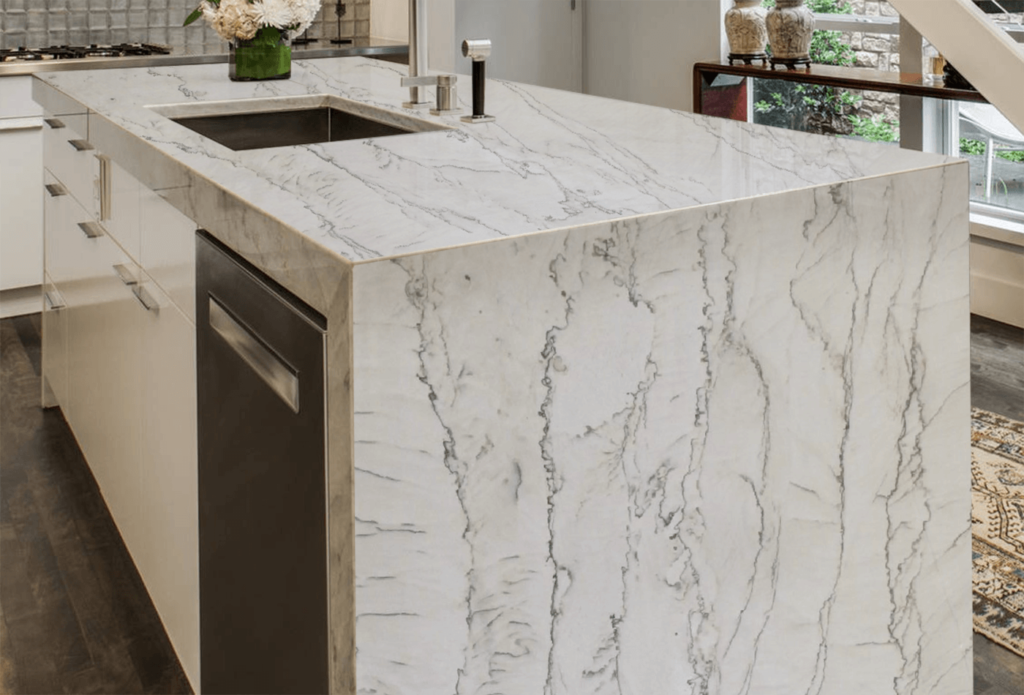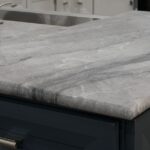When you picture the perfect kitchen island made with all the glory of natural stones, chances are that you don’t consider visible seams as part of its surface. That’s fine, given how these structures are quarried and meticulously processed to leave no trace of segmentation behind. This is particularly true for quartzite slabs, which showcase a beautiful, shining, and linear appearance that fits almost any kind of aesthetic. Is there such a thing as seams in quartzite countertops?
Unfortunately, some complex projects may be built upon a tricky foundation that – especially under bad installation services – can become visually unappealing for many homeowners. In this article, you can learn all about seams in quartzite countertops, from how they’re formed to how they can be avoided in interior design.
Read as well: Do Marble Countertops Stain? 6 Things to Avoid
Are seams in quartzite countertops a common occurrence?
Unfortunately, the answer is yes. Although most professional installations are somehow able to camouflage seams, there are several situations where the joint marks between slabs remain slightly visible – and if that’s your case (or biggest fear), that’s probably the reason you’re here.

As we’ll understand in a bit, seams in quartzite countertops can happen somewhere in their fabrication and polishing processes, both of which share many stages before delivering the complete product to our houses. The installation phase in particular – the time when each piece is meticulously bonded together to form a complete surface – will showcase the quality of the handwork. Great stone fabricators do everything they can – embracing precise measurements, tight joints, and high-quality adhesives – to create a secure bond between the slabs.
Nevertheless, the specific manufacturing of quartzite slabs – just like marble and granite – will heavily depend on a client’s desired structure, including design and color preferences, the durability of the stone chosen, the edging, the layout, and the size of the area covered. In other words, bigger and more ambitious projects will not only cost you more but have higher chances of featuring seams.
Don’t miss: How to Clean Quartzite Countertops
Understanding why seams happen
Seams in quartzite countertops can occur for various reasons, and oftentimes they are necessary for the structure to sustain itself. Here are some common reasons why seams exist in the first place:
- Material size: Quartzite stones are typically manufactured in standard slab sizes (55 to 65 inches in width and 120 to 130 inches in length). If your countertop area is larger than the available slab size, seams may be required to accommodate the extra space.
- Layout and design: The layout and design of your kitchen or bathroom may necessitate seams to achieve the desired shape or to integrate features like sinks, cooktops, and backsplashes.
- Transportation and handling: Countertop slabs are heavy – quartzite can weigh from 12 to 21 lbs a square foot – and can be easily damaged during transportation and handling. To minimize the risk of damage, both to the stone itself and to the house around it – installers may opt to use smaller, more manageable pieces with seams.
- Wall irregularities: Walls and cabinets may not always be perfectly straight or level, so seams are used to accommodate these irregularities and create a more even surface.
- Limited material availability: In some cases, it may be challenging to source a single large slab of a specific quartzite stone, particularly the rarer versions. Seams are used when working with smaller pieces or remnants to complete the installation.
- Budget constraints: Likewise, using smaller pieces or remnants of quartzite can be a cost-effective solution, especially if the homeowner is on a tight budget.
- Weight considerations: In some situations, the weight of a single, large slab may be too heavy for the cabinet structure underneath or the building foundation. Smaller pieces of quartzite can help distribute the weight more evenly.
- Edge treatments: Different edge profiles or treatments may require the use of multiple pieces of quartzite, resulting in seams where the pieces are joined.
- Expansion and contraction: Some surfaces can expand and contract with temperature and humidity changes over time – and seams can be used to allow for these natural movements without causing stress on the stone.
- Repair and replacement: In case of damage or the need for replacement, it is easier and more cost-effective to replace a single section of a countertop with a seam rather than the entire countertop.

Once again, while seams may be necessary for the technical reasons listed above, skilled professionals strive to make them as inconspicuous as possible to maintain the aesthetic appeal of your investment. Properly executed seams can be difficult to notice – but they should be eventually sealed and finished to ensure durability and longevity, given the fact that quartzite is a porous and delicate stone.
How to prevent seams in quartzite countertops (or naturally mask them)
Even though seams are an inherent aspect of quartzite countertops, skilled fabricators strive to make them as inconspicuous as possible. As mentioned, the staple goal in the industry is to create seamless transitions by carefully aligning the patterns, colors, and veining of the slabs.
That said, not every scenario is accounted for – and many advanced techniques can be later employed to enhance the appearance of leftover seams, making them virtually undetectable to the naked eye. With the right fabrication and installation techniques, your quartzite countertop can appear as a single, continuous slab wherever it’s located. Check out our best tips to achieve seamless countertops below:
1. Quartzite with other materials
Creating seamless transitions between quartzite and other materials is a creative design strategy that can enhance the aesthetics of your space.

Begin with a well-thought-out design plan to identify where these transitions should occur – a gradual color shift, achieved through variations in shade, pattern, or veining, can make the change less abrupt. Then, select edge profiles for your quartzite countertops that harmonize with adjacent materials. Precise joints and matching grout or joint lines further contribute to a seamless appearance, while decorative borders in the transition area add an element of sophistication that visually separates materials.
2. Architectural elements and lighting
Incorporating architectural features such as columns, pillars, or half-walls in the transition area serves both functional and design purposes.
Custom patterns can make your space unique – transition profiles, trim pieces, and moldings bridge the gap between materials, while metal or wooden transition strips can be customized to match your design aesthetic. Properly placed lighting, like under-cabinet lighting or pendant lights, can draw attention away from transitions, allowing the materials to shine through.
3. Special adhesives
The final option is a color-matching adhesive that closely resembles the quartzite’s color to reduce seam visibility.
Here, precise and careful application is crucial, ensuring clean and dry edges that securely join the quartzite sections with clamps or suction cups. Address any visible seams by applying a matching stone epoxy or filler that levels with the countertop surface. Then, smooth and polish the seam with various grits of sandpaper or polishing tools to achieve a virtually imperceptible transition. Careful attention to adhesive choice and application is essential for both functional and aesthetic success!
You have seamless, high-quality quartzite countertops waiting for you!
If you’re looking for an expert team to deal with your dream project, count on Eagle Stones to conceive a seamless countertop surface at your home. Our staff offers a wide catalog of natural stones – with products from all over the world – and professional installation and maintenance services in the city of Sarasota, FL, and all its surrounding counties.
Get a free quote on the best quartzite countertops out there! Contact us today to learn more about us – we’ll be waiting for you to reach out.
For hardscape enthusiasts, we also sell paving stones – click here for further information.



